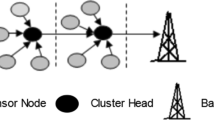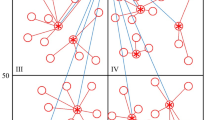Abstract
Wireless sensor network is a group of nodes combined with tiny sensors equipped with transceiver parts used for sensing, monitoring, and data collecting in various environments. It is not possible to support the battery support to the sensors while placed in an unmanned area. Hence, the sensor's energy should be vital, and it is very crucial. Combining the techniques of clustering and proper routing is one of the efficient schemes to save the energy of the sensor nodes. During the clustering process, cluster heads can be chosen with utmost care for load balancing. Along with cluster head selection, this proposed work also focussed on two major things. First, the appropriate relay node can be selected using the fuzzy inference system with sensor energy level as one input and the distance between the relay node and the cluster head node as another input. Secondly, the mobile sink collects the aggregated data from the relay node and sends it to the base station. On combining these two schemes, mobile sink and fuzzy based relay node routing Protocol is proposed. Simulation result shows that the proposed protocol has an improved number of alive nodes and a better network lifetime in terms of energy consumption compared with the existing schemes.






Similar content being viewed by others
References
Nazir, B., & Hasbullah, H. (2010). Mobile sink based routing protocol (MSRP) for prolonging network lifetime in clustered wireless sensor network. In: 2010 international conference on computer applications and industrial electronics, pp. 624–629.
Salarian, H., Chin, K.-W., & Naghdy, F. (2013). An energy-efficient mobile-sink path selection strategy for wireless sensor networks. IEEE Transactions on Vehicular Technology, 63(5), 2407–2419.
Weifa, L., Jun, L., & Xu, X. (2010). Prolonging network lifetime via a controlled mobile sink in wireless sensor networks. IEEE Global Telecommunications Conference (GLOBECOM 2010), Miami, USA, pp 1–6.
Hamida, E. B., & Chelius, G. (2008). Strategies for data dissemination to mobile sinks in wireless sensor networks. IEEE Wireless Communications, 15(6), 31–37.
Thakkar, A., & Kotecha, K. (2014). Cluster head election for energy and delay constraint applications of wireless sensor network. IEEE Sensors Journal, 14(8), 2658–2664.
Kim, H.-Y., & Kim, J. (2015). An energy-efficient balancing scheme in wireless sensor networks. Wireless Personal Communications, 86(1), 1–13.
Abo-Zahhad, M., Ahmed, S. M., & Sasaki, S. (2015). Mobile sink based adaptive immune energy efficient clustering protocol for improving the lifetime and stability period of wireless sensor networks. IEEE Sensors Journal, 15(8), 4576–4586.
Wen, W., Zhao, S., Shang, C., & Chang, C.-Y. (2018). EAPC: energy- aware path construction for data collection using mobile sink in wireless sensor networks. IEEE Sensors Journal, 18(2), 890–901.
Chatzigiannakis, I., Kinalis, A., & Nikoletseas, S. (2008). Efficient data propagation strategies in wireless sensor networks using a single mobile sink. Computer Communications, 31(5), 896–914.
Wang, C.-F., Shih, J.-D., Pan, B.-H., & TinYu, Wu. (2014). A network lifetime enhancement method for sink relocation and its analysis in wireless sensor networks. IEEE Sensors Journal, 14(6), 1932–1943.
Ahmad, A., Javaid, N., Khan, Z. A., Qasim, U., & Alghamdi, T. A. (2014). (ACH)2: Routing scheme to maximize lifetime and throughput of WSNs. IEEE Sensors Journal, 14(10), 3516–3532.
Jain, S., Pattanaik, K. K., Verma, R. K., Bharti, S., & Shukla, A. (2021). Delay-aware green routing for mobile-sink-based wireless sensor networks. IEEE Internet of Things Journal, 8(6), 4882–4892. https://doi.org/10.1109/JIOT.2020.3030120
Wang, Y., & Chen, K. (2019). Efficient path planning for a mobile sink to reliably gather data from sensors with diverse sensing rates and limited buffers. IEEE Transactions on Mobile Computing, 18(7), 1527–1540. https://doi.org/10.1109/TMC.2018.2863293
Habib, M. A., Saha, S., Razzaque, M. A., Mamun-Or-Rashid, M., Hassan, M. M., Pace, P., & Fortino, G. (2020). Lifetime maximization of sensor networks through optimal data collection scheduling of mobile sink. IEEE Access, 8, 163878–163893. https://doi.org/10.1109/ACCESS.2020.3021623
He, X., Fu, X., & Yang, Y. (2019). Energy-efficient trajectory planning algorithm based on multi-objective PSO for the mobile sink in wireless sensor networks. IEEE Access, 7, 176204–176217. https://doi.org/10.1109/ACCESS.2019.2957834
Lu, Y., Sun, N., & Pan, X. (2019). Mobile sink-based path optimization strategy in wireless sensor networks using artificial bee colony algorithm. IEEE Access, 7, 11668–11678. https://doi.org/10.1109/ACCESS.2018.2885534
Senthil Kumaran, R., & Nagarajan, G. (2017). Enhancement of network lifetime in wireless sensor networks using energy efficient mobile sink based routing protocol (EEMSBRP). CIIT International Journal of Wireless Communication, 9(3), 45–49.
Senthil Kumaran, R., & Suganya, P. (2021). Network lifetime enhancement in wireless sensor networks using energy aware clustering with fuzzy system. IOP J Phys Conf Ser. https://doi.org/10.1088/1742-6596/1717/1/012069.
Senthil Kumaran, R., & Nagarajan, G. (2016). Enhancement of network lifetime in wireless sensor networks (WSNs) using residual energy. International Journal of Image Mining (Inderscience), 2(2), 116–128.
Ren, J., Zhang, Y., Zhang, K., Liu, A., Chen, J., & Shen, X. S. (2016). Lifetime and energy hole evolution analysis in data-gathering wireless sensor networks. IEEE Transactions on Industrial Informatics, 12(2), 788–800.
Donta, P. K., Amgoth, T., & Annavarapu, C. S. R. (2021). An extended ACO-based mobile sink path determination in wireless sensor networks. Journal of Ambient Intelligence and Humanized Computing, 12, 8991–9006. https://doi.org/10.1007/s12652-020-02595-7
Donta, P. K., Rao, B. S. P., Amgoth, T., Annavarapu, C. S. R., & Swain, S. (2020). Data collection and path determination strategies for mobile sink in 3D WSNs. IEEE Sensors Journal, 20(4), 2224–2233. https://doi.org/10.1109/JSEN.2019.2949146
Sathyapriya, L., & Jawahar, A. (2021). Energy efficient clustering algorithm based on particle swarm optimization technique for wireless sensor networks. Wireless Personal Communications. https://doi.org/10.1007/s11277-021-08239-z
Author information
Authors and Affiliations
Corresponding authors
Additional information
Publisher's Note
Springer Nature remains neutral with regard to jurisdictional claims in published maps and institutional affiliations.
Rights and permissions
About this article
Cite this article
Senthil Kumaran, R., Nagarajan, G. Mobile sink and fuzzy based relay node routing protocol for network lifetime enhancement in wireless sensor networks. Wireless Netw 28, 1963–1975 (2022). https://doi.org/10.1007/s11276-022-02960-8
Accepted:
Published:
Issue Date:
DOI: https://doi.org/10.1007/s11276-022-02960-8




